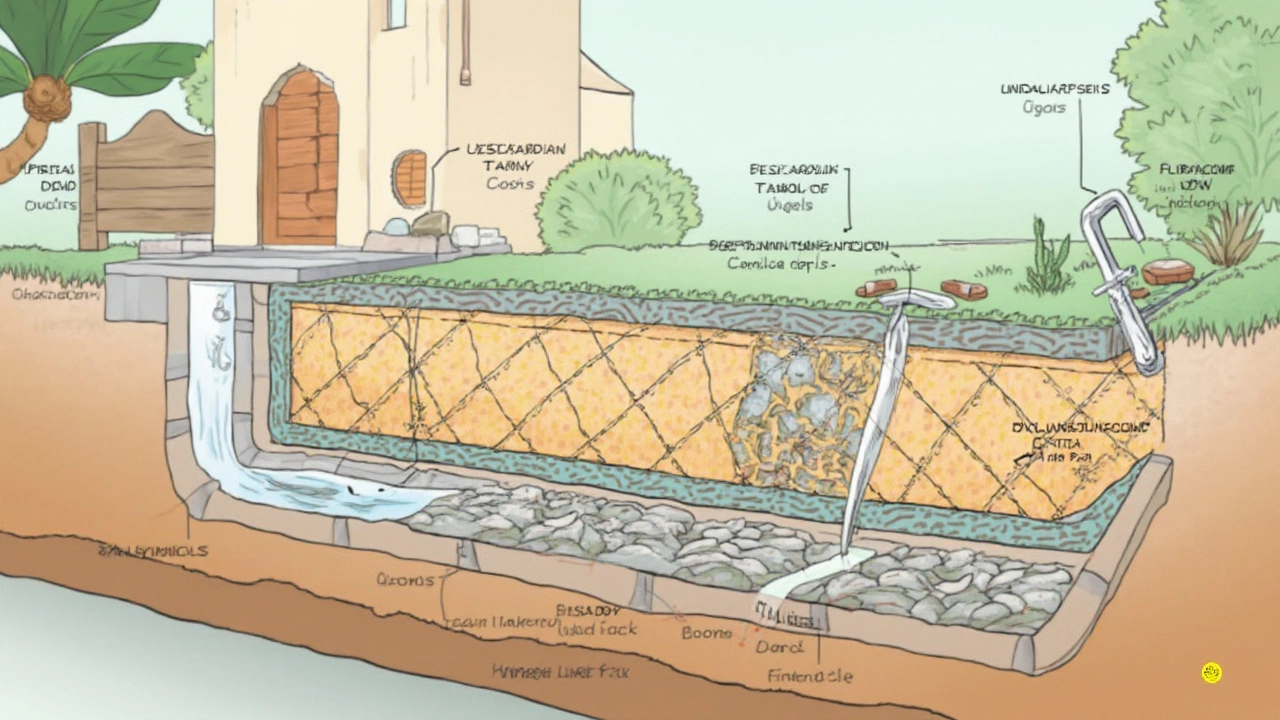Most people don't think about their foundation until something goes wrong. Maybe you've noticed a crack running along your wall or doors that suddenly won’t shut right. It feels like a big deal because, honestly, it kind of is. The foundation keeps your whole house steady, so when it starts acting up, ignoring it won’t make it better.
So how do you pick the best fix? Foundation problems can range from hairline cracks that look ugly to bigger issues like parts of your home sinking. The truth is, there isn’t a one-size-fits-all answer. Each repair method tackles different problems, from minor surface fixes to major structural lifts.
The repair world is packed with different terms: slab jacking, piering, epoxy injections — all sound technical, right? But you don’t have to be an engineer to get the basics. Picking the right method means looking at what’s happening with your own house, the soil it sits on, and how long you actually want the repair to last.
Here’s what nobody really tells you: the best repair is the one that fits your exact problem and your budget—not the one that sounds fanciest or costs the most. Let’s break down what really works, why it does, and how to make sure you’re getting a repair that sticks. If you’ve got foundation questions, you’re in the right place.
- Why Foundations Fail
- Popular Repair Methods Explained
- How to Choose the Right Solution
- Tips for Avoiding Future Problems
Why Foundations Fail
A lot of folks are shocked to find out just how easy it is for things under their home to go wrong. The most common reason for foundation repair? It’s almost always moisture. Either there’s too much water under your house or not enough, and both can cause chaos.
When clay soil gets wet, it swells up and can push against your foundation. When it dries out, it shrinks and leaves gaps. Houses built on this type of soil see more cracks and shifting than those on sand or rock. A survey from the American Society of Civil Engineers found that about 60% of homes in the U.S. built on clay-rich soil deal with some type of foundation movement.
Leaks are another biggie. Plumbing leaks, poor drainage, or clogged gutters all let water build up where you don’t want it. And all that extra moisture makes foundations settle unevenly. A tree too close to your house can even tip the scale—roots soak up water and dry out the soil, shrinking the support around your home’s base.
- Poor construction: Cheap materials or sloppy work mean your foundation never stood a chance.
- Big temperature swings: Sudden freezes and thaws make the ground expand and contract, stressing concrete over and over.
- Earthquakes or vibrations: Live near train tracks or a busy road? All that shaking can slowly nudge your foundation out of whack.
- Old age: Like everything else, foundations wear out. Concrete gets brittle, and small cracks just get bigger with time.
Here's a quick glance at these main troublemakers:
| Cause | How it Damages |
|---|---|
| Water (Too Much or Too Little) | Shifts soil, creates pressure, causes sinking or cracks |
| Poor Drainage | Localized soil erosion, uneven settling |
| Trees and Roots | Dry out earth, leave voids under foundation |
| Construction Quality | Sets up early weaknesses |
| Age | Cracks, general wear, and tear |
Spotting the cause of your own foundation problem doesn’t just help fix it—it can stop the same headache from coming back later. Learning what’s really going on beneath your feet is always step one before tackling any repair.
Popular Repair Methods Explained
When you start shopping for foundation repair, contractors throw around terms like slab jacking, piering, and epoxy injections. Some of them sound high-tech, but each has its time and place. Let’s get into what actually works and when it’s best to use each method.
Slab Jacking (or Mudjacking): This fix is common for homes with concrete slab foundations. Crews drill small holes in the concrete and pump in a mixture (usually cement and soil) underneath. The pressure lifts the slab back into place. People like slab jacking because it's pretty quick—you can sometimes use your floors again the same day. But it’s not a forever fix if the soil under your house keeps shifting or washing out. It works well for minor sinking, but not for major structural issues.
Piering (Push Piers or Helical Piers): This one’s the go-to solution if your house is seriously out of level or you’ve got big cracks. Workers drive steel piers deep into the ground until they hit solid soil or bedrock. Then your house gets jacked up and rested on those piers. This method costs more, but it lasts a long time because it doesn’t depend on loose soil under your house. Piering is popular where homes settle due to clay soils or uneven moisture around the place.
Epoxy and Polyurethane Injections: Got a crack? This fix is fast and not too pricey. The crew injects epoxy resin (or polyurethane foam) into the crack, which bonds the concrete back together and seals up water leaks. This is best for non-structural cracks. If you have a major shifting problem, injections won’t stop the foundation from moving—they just fill the gap.
Here’s a quick look at how these methods stack up:
| Method | Good For | Average Cost | Timeline |
|---|---|---|---|
| Slab Jacking | Minor sinking slabs | $500 - $1,500 | 1-2 days |
| Piering | Major structural shifts | $3,000 - $10,000+ | 3-10 days |
| Epoxy/Poly Foam | Hairline and non-structural cracks | $350 - $1,200 | Half to full day |
You might also hear about waterproofing systems—these don’t really fix foundation movement, but they help manage water around and under your house. If water is your main problem (like in a super rainy area), adding drains and sump pumps can prevent issues from getting worse.
Bottom line: the best foundation repair method depends on what’s actually happening under your house. You want to match the problem with the right solution—not just pick what’s cheapest or easiest.

How to Choose the Right Solution
Deciding on the best method for foundation repair starts with figuring out what kind of problem you really have. Not all cracks mean disaster, but ignoring the wrong kind of movement can cost a fortune down the road. You should look at the pattern, size, and location of cracks, as well as whether doors and windows are sticking or floors are uneven.
The soil under your house matters more than you might think. Houses on clay are famous for shifting after heavy rain or drought, while sandy soil is usually less dramatic. If you’re unsure, a quick soil test can tell you a lot about what repairs will work — or fail — later. And here’s a big one: just patching up a crack might fix how it looks, but it won’t stop your home from settling if the soil keeps moving.
Here’s a simple way to line up your options:
- If you have tiny, hairline cracks and no other issues: an epoxy injection can usually seal them up and prevent leaks.
- If your foundation is uneven but mostly intact: slab jacking (also called mudjacking) can lift sunken sections back into place by pumping a cement mixture underneath.
- For serious settling, especially if parts of the house are really sinking: piering (driving steel or concrete piers deep into the ground) is the heavy-duty fix most pros trust. It’s pricier, but it lasts much longer.
- If you see wide cracks with big shifts or water pooling around your foundation: sometimes a full drainage solution or major structural work is needed before repairs even start.
Getting a foundation inspection from someone who isn’t trying to sell you something is huge. Look for an independent structural engineer. They’ll actually tell you if you need that major repair or just a watch-and-wait approach. Some states require licensing and offer look-up tools for foundation contractors, so don’t skip checking credentials.
Let’s talk numbers. According to HomeAdvisor, slab jacking usually costs $500 to $1,500, while piering can run $1,000 to $3,000 per pier (and you’ll often need several). Quick epoxy fixes are cheaper but won’t solve bigger problems. Here’s a table showing typical cost ranges for common foundation repair methods:
| Repair Method | Average Cost | Best For |
|---|---|---|
| Epoxy Injection | $300 - $800 per crack | Small, non-structural cracks |
| Slab Jacking | $500 - $1,500 | Sunken concrete, uneven slabs |
| Piering | $1,000 - $3,000 per pier | Major settling, structural issues |
No matter what you pick, always ask the contractor for photos of past jobs, details on warranties, and real customer reviews. Cheap quick fixes usually don’t last if there’s a bigger problem underneath, so weigh that upfront cost against the risk of doing major repairs later on.
Tips for Avoiding Future Problems
Once you’ve dealt with foundation repair, you definitely don’t want to do it again. The best way to dodge another headache is with some pretty basic upkeep and a keen eye on your home’s surroundings.
Water is enemy number one for foundations. Too much or too little can both mess with the soil under your house, causing it to shrink, swell, or wash away. That’s why managing water is the first rule of keeping your foundation healthy.
- Keep your gutters and downspouts clear. Make sure water moves away from — not toward — your foundation. Extending downspouts at least 6 feet from the house makes a big difference.
- Watch how your yard slopes. The ground should slope away from your foundation. If you notice water pooling near the base, add dirt or regrade the area to push it outwards.
- Avoid piling mulch or landscaping too close to the house. This traps moisture against the foundation, which isn’t good at all.
- Don’t plant trees right next to your foundation. Large roots can suck moisture out of the soil and even crack your slab or pier, especially if you have clay soil.
- Keep an eye on plumbing leaks. Hidden leaks under your house can quietly ruin your foundation. Monitor your water bill for spikes — a sudden increase might mean trouble underground.
If you’re living in a place prone to dry spells followed by heavy rain (like Texas or parts of the Midwest), the soil around your home is going to move a lot. Some folks install foundation soaker hoses to keep moisture levels steady during long dry periods — it’s a simple trick that can help, especially for homes on clay soil.
Foundation issues don’t always start big. If you catch things early, like a hairline crack or a little door sticking, you can save yourself some serious cash and hassle. Set a yearly reminder to take a walk around the inside and outside of your house looking for new cracks, sticking doors, or sloping floors.
| Quick Prevention Tips | How Often? |
|---|---|
| Clean Gutters/Downspouts | Each season, or after storms |
| Check for Yard Drainage | Every spring and fall |
| Inspect for Cracks or Gaps | Once a year |
| Look for Plumbing Leaks | Every water bill cycle |
Taking these steps seriously can stretch the life of your foundation repair and even keep you from needing major fixes in the first place. It’s really about paying attention and not letting little problems turn into big, expensive ones.
